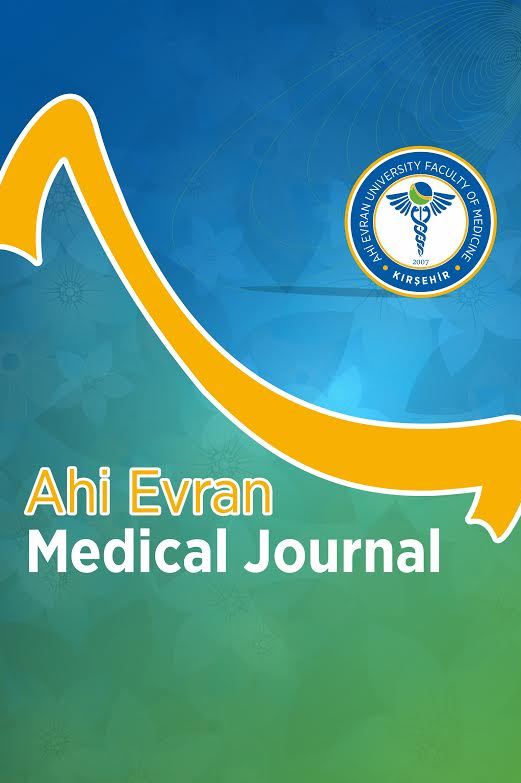Yenidoğan Yoğun bakım Ünitelerinde Palyatif Bakımın Önemi ve Gerekliliği
Amaç: Palyatif bakım antenatal dönemden itibaren annelere, doğum sonrası bebeklere/ailelerine gerekli desteği vermeyi amaçlamaktadır. Bu çalışmada palyatif bakım verilmesi gereken durumları tespit etmeyi amaçladık.Gereç ve Yöntem: Yenidoğan yoğunbakım ünitesine yatırılan doğum ağırlığı ≤ 500 gr, gebelik yaşı 23 haftanın altında olan infantlar, ölümcül veya yaşamla bağdaşmayan bir konjenital anomali ya da malformasyonu olan (trizomiler, sendromlar, ağır konjenital kalp hastalığı vs), ağır neonatal ensefalopati sekeli, konjenital kas hastalığı olan infantlar ve antenatal takiplerde ağır konjenital anomali tespit edilerek gebelik sonlandırması (terminasyonu) veya terapötik abortus yapılan gebeler çalışmaya alındı.Bulgular: Doğum ağırlığı ≤ 500 gr ve/veya gebelik yaşı 23 haftanın altında olan bebeklerden yaşayan olmadığı belirlendi. Trizomi 13,18 ve ağır konjenital kalp hastalığı olan, konjenital kas hastalığı, ağır neonatal ensefalopati, ağır konjenital hidrosefali olan bebeklerin yaşam sonuna kadar palyatif bakım gerekliliği izlendi. Antenatal gebe takiplerinde ağır konjenital anomali ve diğer nedenler saptanan fetusların terminasyonla sonlandığı belirlendi. Sonuç: Antenatal dönemden itibaren palyatif bakımı başlatma endikasyonlarını açıklayan, ailenin bakımı/desteklenmesi, eve geçiş, ömür boyu bakım ve yas hizmetleri/desteği gibi konuları da içeren ulusal bir rehbere ihtiyaç olduğu görülmektedir.
Anahtar Kelimeler:
palyatif bakım, yenidoğan, antenatal, trizomi, konjenital anomali
The Importance and Requirement of Palliative Care in Newborn Intensive Care Units
Purpose: Palliative care aims to give the necessary support to the mothers and infants / families after birth since the antenatal period. In this study, we aimed to determine the cases those palliative care should be given. Materials and Methods: Infants with birth weight ≤ 500 gr, gestational age <23 weeks and infants with a lethal or life threatening congenital anomaly or malformation (trismomes, syndromes, severe congenital heart disease, etc.), severe neonatal encephalopathy sequelae, congenital muscular disease were eligible. Fetus with severe congenital anomaly detected in antenatal follow-ups and resulted in (termination) therapeutic abortion was enrolled. Results: It has been determined that birth weight ≤ 500gr and / or infants whose gestational age was less than 23 weeks were not alive. Infants with trisomy 13, 18 and severe congenital heart disease, congenital muscle disease, severe neonatal encephalopathy, severe congenital hydrocephaly were determined to require palliative care until the end of life. It was identified that the fetuses which detected severe congenital anomaly and other causes during antenatal visits resulted in termination. Conclusion: Beginning from the antenatal period, it seems that there is a need for a national cohort that includes indications for palliative care initiation, care / support for family, transition to home, lifelong care and mental services / support.
Keywords:
antenatal, palliative care, newborn, trisomy, congenital anomaly,
___
- 1. Diqhe MP, Muckaden MA, Manerkar SA, Duraisamy BP. Is there a Role of Palliative Care in the Neonatal Intensive Care Unit in India? Indian J Palliat Care. 2011 May-Aug; 17(2): 104–7.
- 2. Gluck L. Neonatal intensive care a history of excellence-A Symposium Commemorating Child Health Day. NIH Publication No.92-2786. 1992.
- 3. Catlin A, Carter B. Creation of a neonatal end-of-life palliative care protocol. J Perinatol. 2002;22:184–95.
- 4. National Consensus Project for Quality Palliative Care, 2009. Clinical practice guidelines for quality palliative care (2nd ed, 9-10). Available at: http:/www.nationalconsensusproject.org. Accessed December.2014
- 5. Romesberg TL. Understanding grief: A component of neonatal palliative care. J Hosp Palliat Nurs 2004;6:161-70.
- 6. World Health Organization. WHO definition of palliative care. Available at: http://www.who.int/selection_medicines/committees/expert/19/applications/PalliativeCare_8_A_R.pdf.Accessed January.2015.
- 7. American Academy of Pediatrics, Committee on Bioethics and Committee on Hospital Care. Palliative care for children. Pediatrics 2000;106:351-7.
- 8. Carter BS. Providing palliative care for newborns. Pediatric Annals 2004;33:770–7.
- 9. Romesberg TL. Building a case for neonatal palliative care. Neonatal Network 2007;26:111-5.
- 10. Gale G, Brooks A. Implementing a palliative care program in a newborn intensive care unit. Adv Neonatal Care 2006;6:37–53.
- 11. Carter BS, Hubble C, Weise KL. Palliative medicine in neonatal and pediatric ıntensive care. Child Adolesc Psychiatr Clin N Am 2006;15:759–77.
- 12. National Association of Neonatal Nurses. Board of Directors. Position Statement. #3051. Palliative care for newborns and infants. September 2010. Avaliable at: http://www.nann.org/ uploads/files/Palliative_Care-final2-in_new_template_01-07-11. pdf. Accessed December 2014.
- 13. Van Dijk M, Simons S, Tibboel D. Pain assessment in Neonates. Paediatr Perinat Drug Ther. 2004;6:97–103.
- 14. Pierucci RL, Kirby RS, Leuthner SR. End-of-life care for neonates and infants: The experience and effects of a palliative care consultation service. Pediatricsnone. 2001;108:653–60.
- 15. Hazzard A, Weston J, Gutterres C. After a child's death: Factors related to parental bereavement. J Dev Behav Pediatr. 1992;13:24–30.
- 16. Dyregrov A, Matthiesen SB. Parental grief following the death of an infant – a follow up over one year. Scand J Psychol. 1991;32:193–207.
- 17. Ngozi E, Edi O, Evan V. Bereavement support in Neonatal intensive care. Infant. 2005;1:203–6.
- 18. Moriette G, Rameix S, Azria E, Fournié A, Andrini P, Caeymaex L, et al. Very premature births: Dilemmas and management. Part 1. Outcome of infants born before weeks of postmenstrual age, and definition of a gray zone. Arch Pediatr. 2010;17:518–26.
- 19. Cuttini M, Nadai M, Kaminski M, Hansen G, de Leeuw R, Lenoir S, et al. End-of-life decisions in neonatal intensive care: Physicians’ self-reported practices in seven European countries. Lancet. 2000;355:2112–8.
- 20. Brien IO, Duffy A, Shea EO. Medical futility in children's nursing: Making end-of-life decisionsnone. Br J Nurs. 2010;19:352–6.
- 21. Young Seideman R, Watson MA, Corff KE, Odle P, Haase J, Bowerma JL. Parent stress and coping in NICU and PICU. J Pediatr Nursnone. 1997;12:169–77.
- 22. Muraskas J, Parsi K. The cost of saving the tiniest lives: NICUs versus prevention. Virtual Mentor: Am Med Assoc J Ethics. 2008;10:655–8.
- Yayın Aralığı: Yılda 3 Sayı
- Başlangıç: 2017
- Yayıncı: Kırşehir Ahi Evran Üniversitesi
Sayıdaki Diğer Makaleler
Tiroidektomi Uygulanan Hastaların Retrospektif Analizi
Kadir Yıldırım, Nuraydın Özlem
İSOTRETİNOİN KULLANAN BİR İNTİHAR GİRİŞİMİ OLGUSU
Yusuf ATAN, Ayşegül İYİLEŞEN DAŞ
Meltem HAKKI, Recai DAĞLI, Nazan KOCAOĞLU, Mehmet CANTÜRK, Hakan ATEŞ, Zeynel Abidin ERBESLER
Yenidoğan Yoğun bakım Ünitelerinde Palyatif Bakımın Önemi ve Gerekliliği
Şule ÖZEL, Cüneyt TAYMAN, Sabriye KORKUT, Esra Şükran ÇAKAR, Yaprak Engin ÜSTÜN
